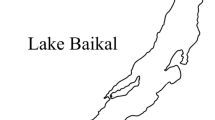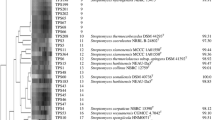Abstract
This study describes actinobacteria isolated from the marine sponge Haliclona sp. collected in shallow water of the South China Sea. A total of 54 actinobacteria were isolated using media selective for actinobacteria. Species diversity and natural product diversity of isolates from marine sponge Haliclona sp. were analysed. Twenty-four isolates were selected on the basis of their morphology on different media and assigned to the phylum Actinobacteria by a combination of 16S rRNA gene based restriction enzymes digestion and 16S rRNA gene sequence analysis. The 16S rRNA genes of 24 isolates were digested by restriction enzymes TaqI and MspI and assigned to different groups according to their restriction enzyme pattern. The phylogenetic analysis based on 16S rRNA gene sequencing showed that the isolates belonged to the genera Streptomyces, Nocardiopsis, Micromonospora and Verrucosispora; one other isolate was recovered that does not belong to known genera based on its unique 16S rRNA gene sequence. To our knowledge, this is the first report of a bacterium classified as Verrucosispora sp. that has been isolated from a marine sponge. The majority of the strains tested belong to the genus Streptomyces and three isolates may be new species. All of the 24 isolates were screened for genes encoding polyketide synthases (PKS) and nonribosomal peptide synthetases (NRPS). PKS and NRPS sequences were detected in more than half of the isolates and the different “PKS-I—PKS-II—NRPS” combinations in different isolates belonging to the same species are indicators of their potential natural product diversity and divergent genetic evolution.


Similar content being viewed by others
References
Atlas RM, Park LC (2000) Handbook of Microbiological Media, CRC Press, Inc., Boca Raton, Florida
Ayuso-Sacido A, Genilloud O (2005) New PCR primers for the screening of NRPS and PKS-I systems in actinomycetes: detection and distribution of these biosynthetic gene sequences in major taxonomic groups. Microb Ecol 49:10–24
Bernan S, Greenstein M, Maiese WM (1997) Marine microorganisms as a source of new natural products. Adv Appl Microbiol 43:57–90
Blunt JW, Copp BR, Munro MHG, Northcote PT, Prisep MR (2004) Marine natural products. Nat Prod Rep 21:1–49
Brantley SE, Molinski TF, Preston CM, DeLong EF (1995) Brominated acetylenic fatty acids from Xestospongia sp., a marine sponge bacterial association. Tetrahedron 51:7667–7672
Bull AT (2004) Bountiful oceans: prospecting marine microbial diversity. Trends Drug Discov 5:14–16
Bull AT, Stach JEM, Ward AC, Goodfellow M (2005) Marine actinobacteria: perspectives, challenges and future directions. Antonie van Leeuwenhoek 87:65–79
Bultel-Poncé V, Debitus C, Blond A, Cerceau C, Guyot M (1997) Lutoside: an acyl-1-(acyl-69-mannobiosyl)-3-glycerol isolated from the sponge associated bacterium Micrococcus luteus. Tetrahedron Lett 38:5805–5808
Colquhoun JA, Heald SC, Li L, Tamaoka J, Kato C, Horikoshi K, Bull AT (1998) Taxonomy and biotransformation activities of some deepsea actinomycetes. Extremophiles 2:269–277
Conte RM, Fattorusso E, Lanzotti V, Magno S, Mayol L (1994) Lintenolides, new pentacyclic bioactive sesterterpenes from the Caribbean sponge Cacospongia cf. linteiformis. Tetrahedron 50:849–856
Cook AE, Meyers PR (2003) Rapid identification of filamentous actinomycetes to the genus level using genus-specific 16S rRNA gene restriction fragment patterns. Int J Syst Evol Microbiol 53: 1907–1915
Courtois S, Cappellano CM, Ball M, Francou FX, Normand P, Helynck G, Martinez A, Kolvek SJ, Hopke J, Osburne MS, August PR, Nalin R, Guerineau M, Jeannin P, Simonet P, Pernodet JL (2003) Recombinant environmental libraries provide access to microbial diversity for drug discovery from natural products. Appl Environ Microbiol 69:49–55
Elyakov GB, Kuznetsova T, Mikhailov VV, Maltsev II, Voinov VG, Fedoreyev SA (1991) Brominated diphenyl ethers from a marine bacterium associated with the sponge Dysidea sp. Experientia 47:632–633
Faulkner DJ (2000) Marine natural products. Nat Prod Rep 17:7–55
Felsenstein J (1985) Confidence limits on phylogenies: an approach using the bootstrap. Evolution 39:783–791
Fiedler HP, Brunner C, Bull AT, Ward AC, Goodfellow M, Mihm G (2005) Marine actinomycetes as a source of novel secondary metabolites. Antonie van Leeuwenhoek 87(1):37–42
Finking R, Marahiel AM (2004) Biosynthesis of nonribosomal peptides. Annu Rev Microbiol 28:453–488
Friedrich AB, Fischer I, Proksch P, Hacker J, Hentschel U (2001) Temporal variation of the microbial community associated with the Mediterranean sponge Aplysina aerophoba. FEMS Microbiol Ecol 38:105–113
Ginolhac A, Jarrin C, Gillet B, Robe P, Pujic P, Tuphile K, Bertrand H, Vogel TM, Perriere G, Simonet P, Nalin R (2004) Phylogenetic analysis of polyketide synthase I domains from soil metagenomic libraries allows selection of promising clones. Appl Environ Microbiol 70:5522–5527
Haefner B (2003) Drugs from the deep: marine natural products as drug candidates. Drug Discov Today 8:536–544
Han SK, Nedashkovskaya OI, Mikhailov V, Kim SB, Bae KS (2003) Salinibacterium amurskyense gen. nov., sp. nov., a novel genus of the family Microbacteriaceae from the marine environment. Int J Syst Evol Microbiol 53:2061–2066
Haygood MG, Schmidt EW, Davidson SK, Faulkner DJ (1999) Microbial symbionts of marine invertebrates: opportunities for microbial biotechnology. J Mol Microbiol Biotechnol 1:33–43
Hentschel U, Hopke J, Horn M, Friedrich AB, Wagner M, Hacker J, Moore BS (2002) Molecular evidence for a uniform microbial community in sponges from different oceans. Appl Environ Microbiol 68(9):4431–4440
Hirota H, Tomono Y, Fusetani N (1996) Terpenoids with antifouling activity against barnacle larvae from the marine sponge Acanthella cavernosa. Tetrahedron 52:2359
Imamura N, Nishijima M, Adachi K, Sano H (1993) Novel antimycin antibiotics, urauchimycins A and B, produced by marine actinomycete. J Antibiot (Tokyo) 46:241–246
Imhoff JF, Stöhr R (2003) Sponge-associated bacteria: general overview and special aspects of bacteria association with Halichondria panacea. In: Müller WEG (ed) Sponge (Porifera). Springer, Berlin, pp 35–58
Jensen PR, Dwight R, Fenical W (1991) Distribution of actinomycetes in near-shore tropical marine sediments. Appl Environ Microbiol 57:1102–1108
Jensen PR, Mincer TJ, Williams PG, Fenical W (2005) Marine actinomycete diversity and natural product discovery. Antonie Van Leeuwenhoek. 87(1):43–8
Ketela MM, Halo L, Manukka E, Hakala J, Mantsala P, Ylihonko K (2002) Molecular evolution of aromatic polyketides and comparative sequence analysis of polyketide ketosynthase and 16S ribosomal DNA genes from various Streptomyces species. Appl Environ Microbiol 68:4472–4479
Ketela MM, Virpi S, Halo L, Hautala A, Hakala J, Mantsala P, Ylihonko K (1999) An efficient approach for screening minimal PKS genes from Streptomyces. FEMS Microbiol Lett 180:1–6
Kumar S, Tamura K, Nei M (2004) MEGA3: Integrated software for molecular evolutionary genetics analysis and sequence alignment. Brief Bioinform 5:150–163
Lanoot B, Vancanneyt M, Hoste B, Vandemeulebroecke K, Cnockaert MC, Dawyndt P, Liu ZH, Huang Y, Swings J (2005) Grouping of streptomycetes using 16S-ITS RFLP fingerprinting. Res Microbiol 156:755–762
Lazzarini A, Cavaletti L, Toppo G, Marinelli F (2000) Rare genera of actinomycetes as potential producers of new antibiotics. Antonie van Leeuwenhoek 78: 399–405
Lee YK, Lee JH, Lee HK (2001) Microbial symbiosis in marine sponges. J Microbiol 39:254–264
Li X, De Boer SH (1995) Selection of polymerase chain reaction primers from an RNA intergenic spacer region for specific detection of Clavibacter michiganensis subsp. sepedonicus. Phytopathol 85(8):837–842
Liu W, Ahlert J, Gao Q, Pienkowski EW, Shen B, Thorson JS (2003) Rapid PCR amplification of minimal enediyne polyketide synthase cassettes leads to a predictive familial classification model. Proc Natl Acad Sci 100:11959–11963
Maldonado LA, Stach JEM, Pathom-aree W, Ward AC, Bull AT, Goodfellow M (2005) Diversity of culturable actinobacteria in geographically widespread marine sediments. Antonie van Leeuwenhoek 87:11–18
McVeigh HP, Munro J, Embley TM (1996) Molecular evidence for the presence of novel actinomycete lineages in a temperate forest soil. J Ind Microbiol 17:197–204
Metsä-Ketelä M, Salo V, Halo L, Hautala A, Hakala J, Mäntsälä P, Ylihonko K (1999) An efficient approach for screening minimal PKS genes from Streptomyces. FEMS Microbiol Lett 180:1–6
Mincer TJ, Jensen PR, Kauffman CA, Fenical W (2002) Widespread and persistent populations of a major new marine actinomycete taxon in ocean sediments. Appl Environ Microbiol 68:5005–5011
Moore BS (1999) Biosynthesis of marine natural products: microorganisms and macroalgae. Nat Prod Rep 16:653–674
Moran MA, Rutherford LT, Hodson RE (1995) Evidence for indigenous Streptomyces populations in a marine environment determined with a 16S rRNA probe. Appl Environ Microbiol 61:3695–3700
Musat N, Werner U, Knittel K, Kolb S, Dodenhof T, van Beusekom JE, de Beer D, Dubilier N, Amann R (2006) Microbial community structure of sandy intertidal sediments in the North Sea, Sylt-Romo Basin, Wadden Sea. Syst Appl Microbiol 29(4):333–348
Pathom-aree W, Nogi Y, Sutcliffe IC, Ward AC, Horikoshi K, Bull AT, Goodfellow M (2006) Dermacoccus abyssi sp. nov., a piezotolerant actinomycete isolated from the Mariana Trench. Int J Syst Evol Microbiol 56(6):1233–1237
Perry NP, Ettouati L, Litaudon M, Blunt JW, Munro MHG (1994) Alkaloids from the Antarctic sponge Kirkpatrickia varialosa. Part 1. Variolin B, a new antitumour and antiviral compound. Tetrahedron 50:3987–3992
Rainey FA, Ward-Rainey N, Kroppenstedt RM, Stackebrandt E (1996) The genus Nocardiopsis represents a phylogenetically coherent taxon and a distinct actinomycete lineage: proposal of Nocardiopsaceae fam. nov. Int J Syst Bacteriol 46:1088–1092
Rheims H, Schumann P, Rohde M, Stackebrandt E (1998) Verrucosispora gifhornensis gen. nov., sp. nov., a new member of the actinobacterial family Micromonosporaceae. Int J Syst Bacteriol 48:1119–1127
Riedlinger J, Reicke A, Zähner H, Krismer B, Bull AT, Maldonado LA, Ward AC, Goodfellow M, Bister B, Bischo D, Sűssmuth RD, Fiedler HP (2004) Abyssomicins, inhibitors of the para-aminobenzoic acid pathway produced by the marine Verrucosispora strain AB-18-032. J Antibiot 57:271–279
Saitou N, Nei M (1987) The neighbor-joining method: a new method for reconstructing phylogenetic trees. Mol Bio Evol 4:406–425
Salomon CE, Margarvey NA, Sherman DH (2004) Merging the potential of microbial genetics with biological and chemical diversity: an even brighter future for marine natural product drug discovery. Nat Prod Rep 21:105–121
Schmidt EW, Obraztsova AY, Davidson SK, Faulkner DJ, Haygood MG (2000) Identification of the antifungal peptide-containing symboiont of the marine sponge Theonella swinhoei as a novel d-proteobacterium, “Candidatus Entotheonella palauensis”. Mar Biol 136:969–977
Stierle AC, Cardellina JHI, Singleton FL (1988) A marine Micrococcus produces metabolites ascribed to the sponge Tedania ignis. Experientia 44:1021
Takizawa M, Colwell RR, Hill RT (1993) Solation and diversity of actinomycetes in the Chesapeake Bay. Appl Environ Microbiol 59:997–1002
Vacelet J (1975) Étude en microscopie électronique de l’association entre bactéries et spongiaires du genre Verongia (Dictyoceratida). J Microsc Biol Cell 23:271–288
Vacelet J, Donadey C (1977) Electron microscope study of the association between some sponges and bacteria. J Exp Mar Ecol 30:301–314
Ward AC, Goodfellow M (2004) Phylogeny and functionality: taxonomy as a roadmap to genes. In: Bull AT (ed) Microbial diversity and bioprospecting. ASM Press, Washington, D.C., pp 288–313
Warnecke F, Amann R, Pernthaler J (2004) Actinobacterial 16S rRNA genes from freshwater habitats cluster in four distinct lineages. Environ Microbiol 6:242–253
Webster NS, Hill RT (2001) The culturable microbial community of the Great Barrier Reef sponge Rhopaloeides odorabile is dominated by α–proteobacterium. Mar Biol 138:843–851
Woese CR, Gutell R, Gupta R, Noller HF (1983) Detailed analysis of the higher-order structure of 16S-like ribosomal ribonucleic acids. Microbiol Rev 47(4):621–69
Zhang HT, Lee YK, Zhang W, Lee HK (2006) Culturable actinobacteria from the marine sponge Hymeniacidon perleve: isolation and phylogenetic diversity by 16S rRNA gene-RFLP analysis. Antonie van Leeuwenhoek 90:159–169
Acknowledgements
This research was funded by the Hundred Talents Program of Chinese Academy of Sciences. We also thank the funding of Guangdong Natural Science Fundation (06301287) and the Research Foundation of Science and Technology Planning Project of Guangdong Province (2006B36501004).
Author information
Authors and Affiliations
Corresponding author
Rights and permissions
About this article
Cite this article
Jiang, S., Sun, W., Chen, M. et al. Diversity of culturable actinobacteria isolated from marine sponge Haliclona sp.. Antonie van Leeuwenhoek 92, 405–416 (2007). https://doi.org/10.1007/s10482-007-9169-z
Received:
Accepted:
Published:
Issue Date:
DOI: https://doi.org/10.1007/s10482-007-9169-z




